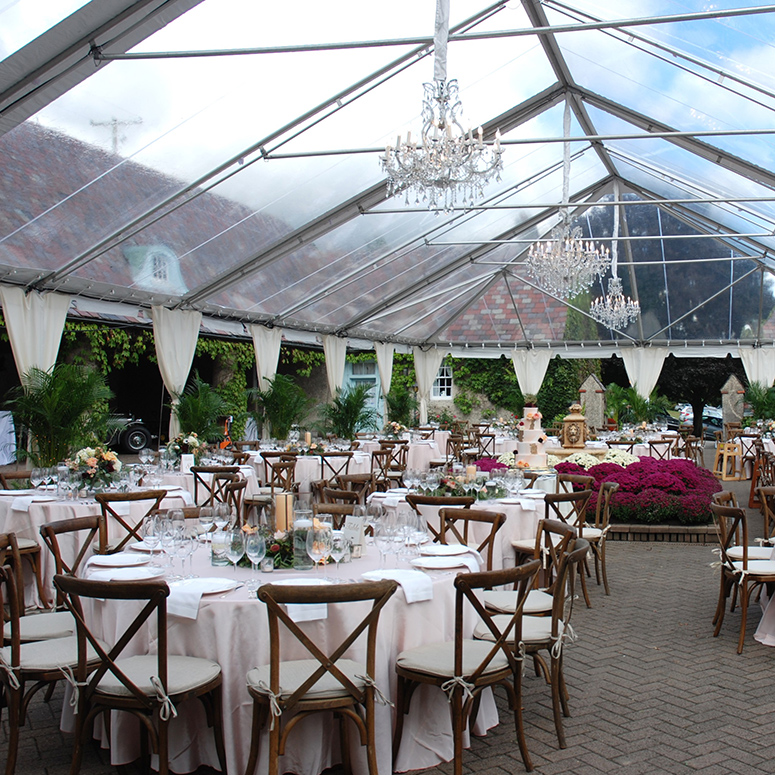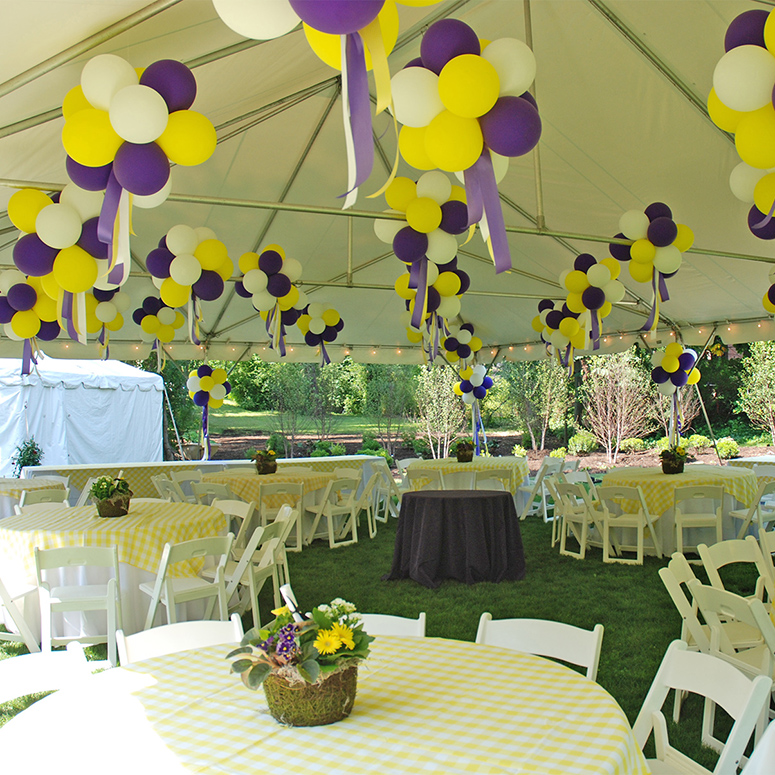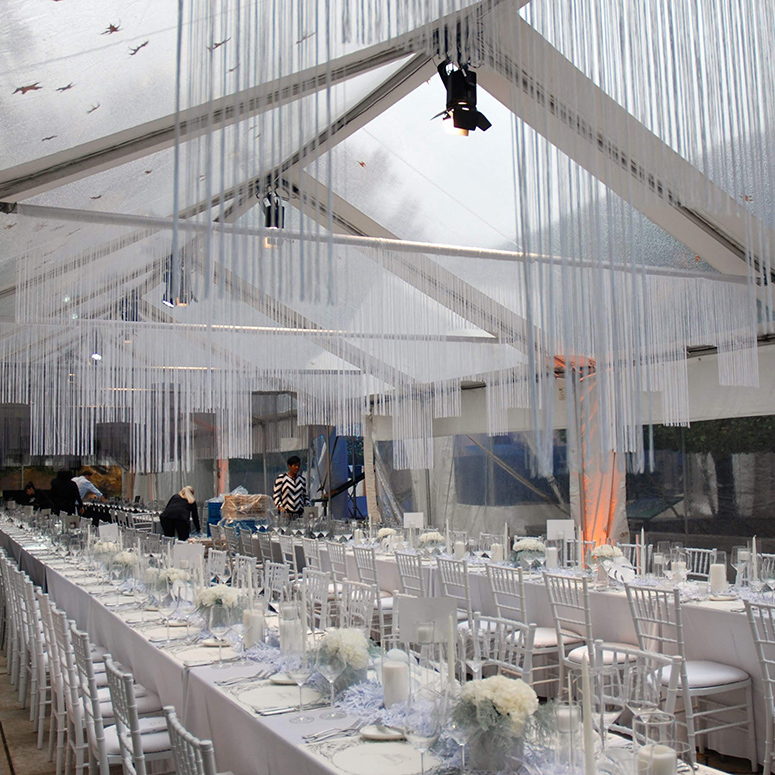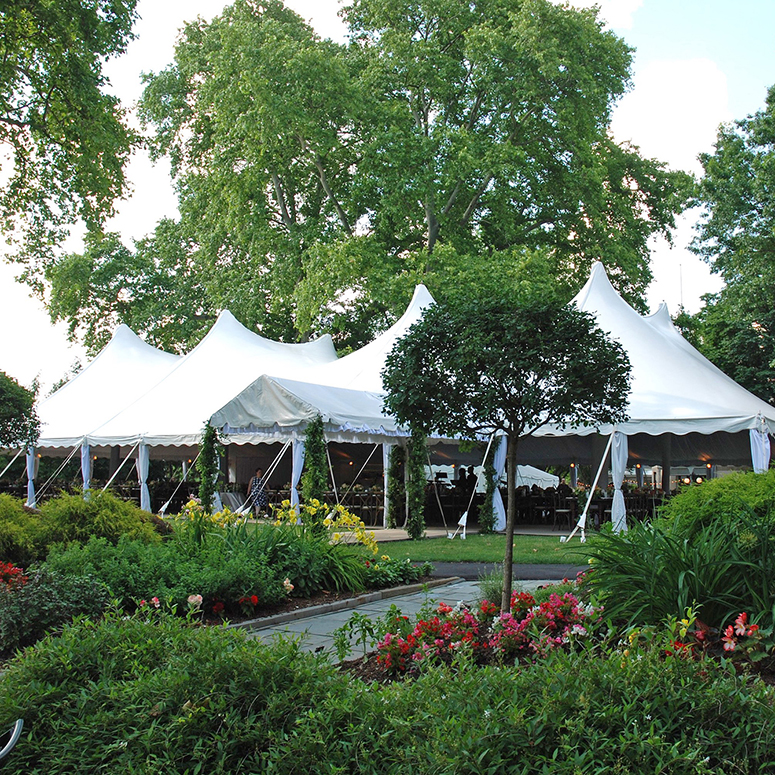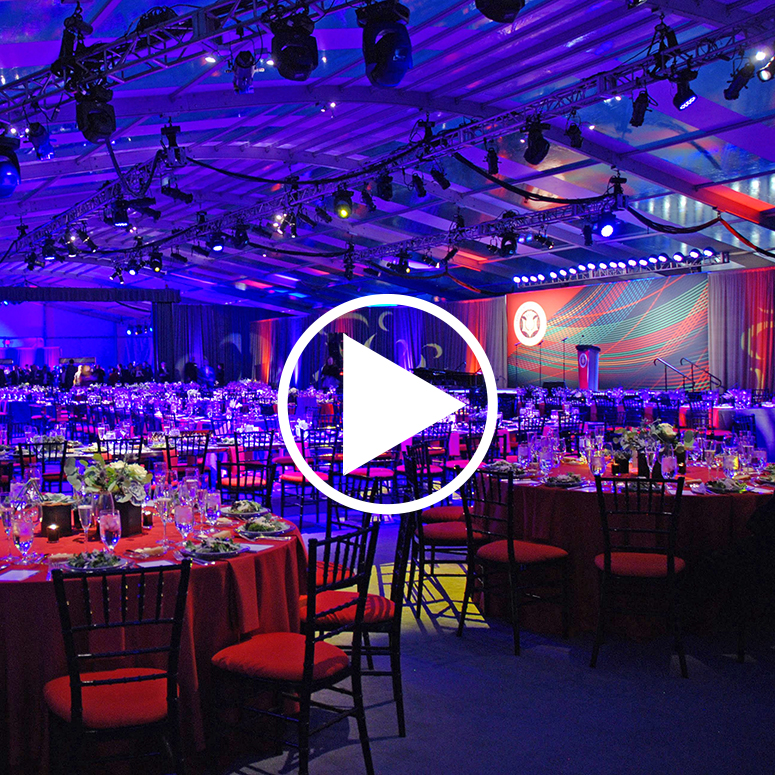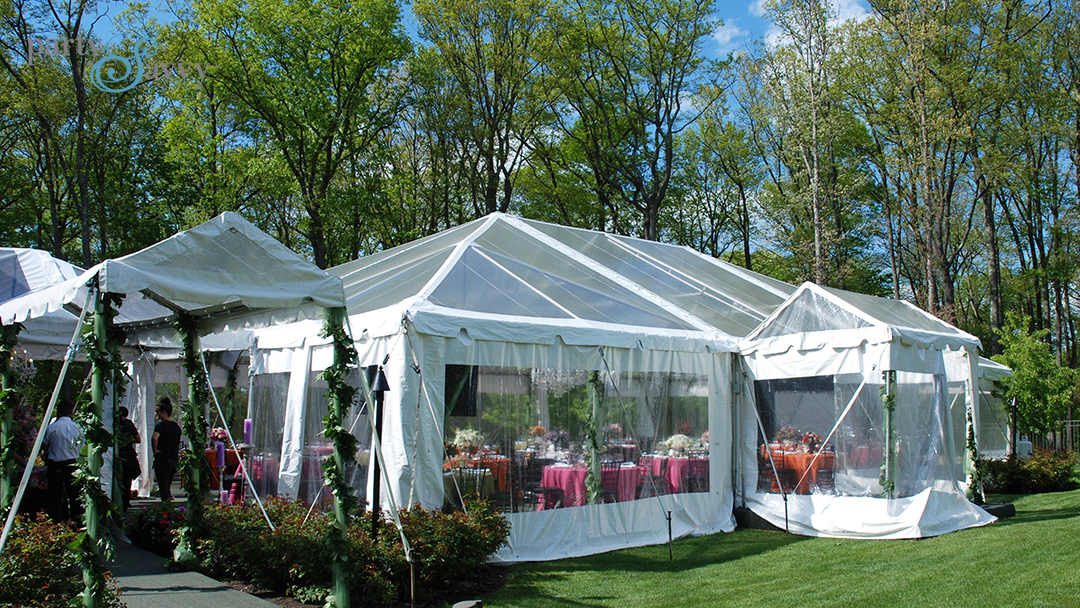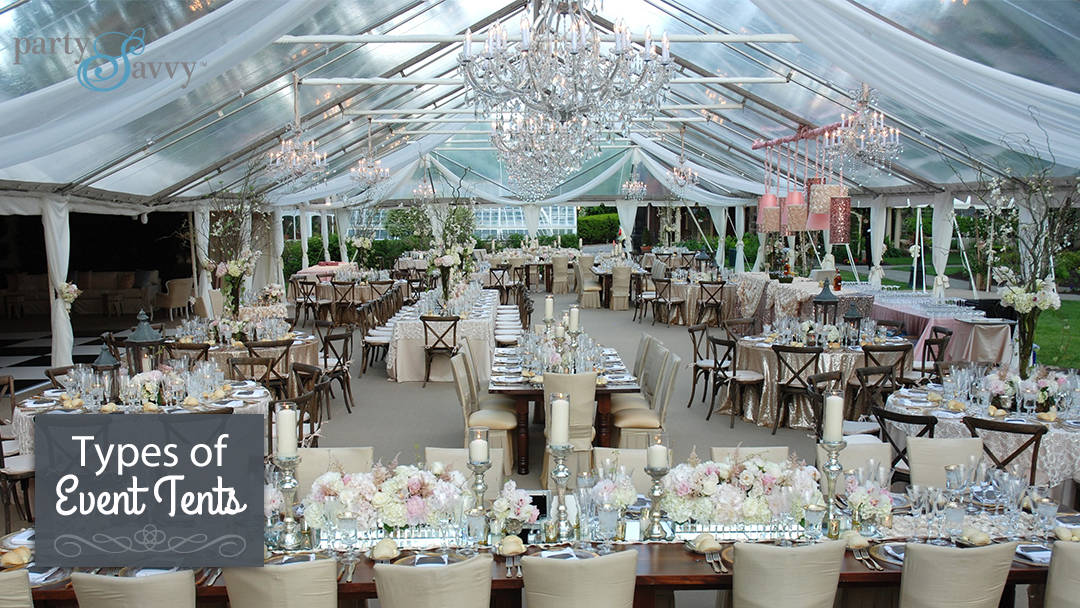If you are planning to host an outdoor event, you will find that many event rental companies offer a variety of tent styles. It is helpful to know the terminology used to describe the various tent types, and which type is the best fit for your particular event.
In broad terms, there are two basic types of event tents; those that have center poles (pole tents), and those that do not, (frame tents).
Pole Tents
Pole tents have some number of center poles, as well as poles around the perimeter; these tents are supported by the center and side poles, as well as web-guys that are attached to the top of each side pole, and to stakes that are driven into the ground around the perimeter of the tent. Pole tents typically require more space than frame tents, due to the fact that the stakes that help hold them up must be placed further away from the perimeter of the tent than the staking distance frame tents typically need.
Pole tents are generally available in two basic types, as follows:
Lightweight Party Canopies, also known as Party Canopies / All Purpose Canopies / Self-set tents
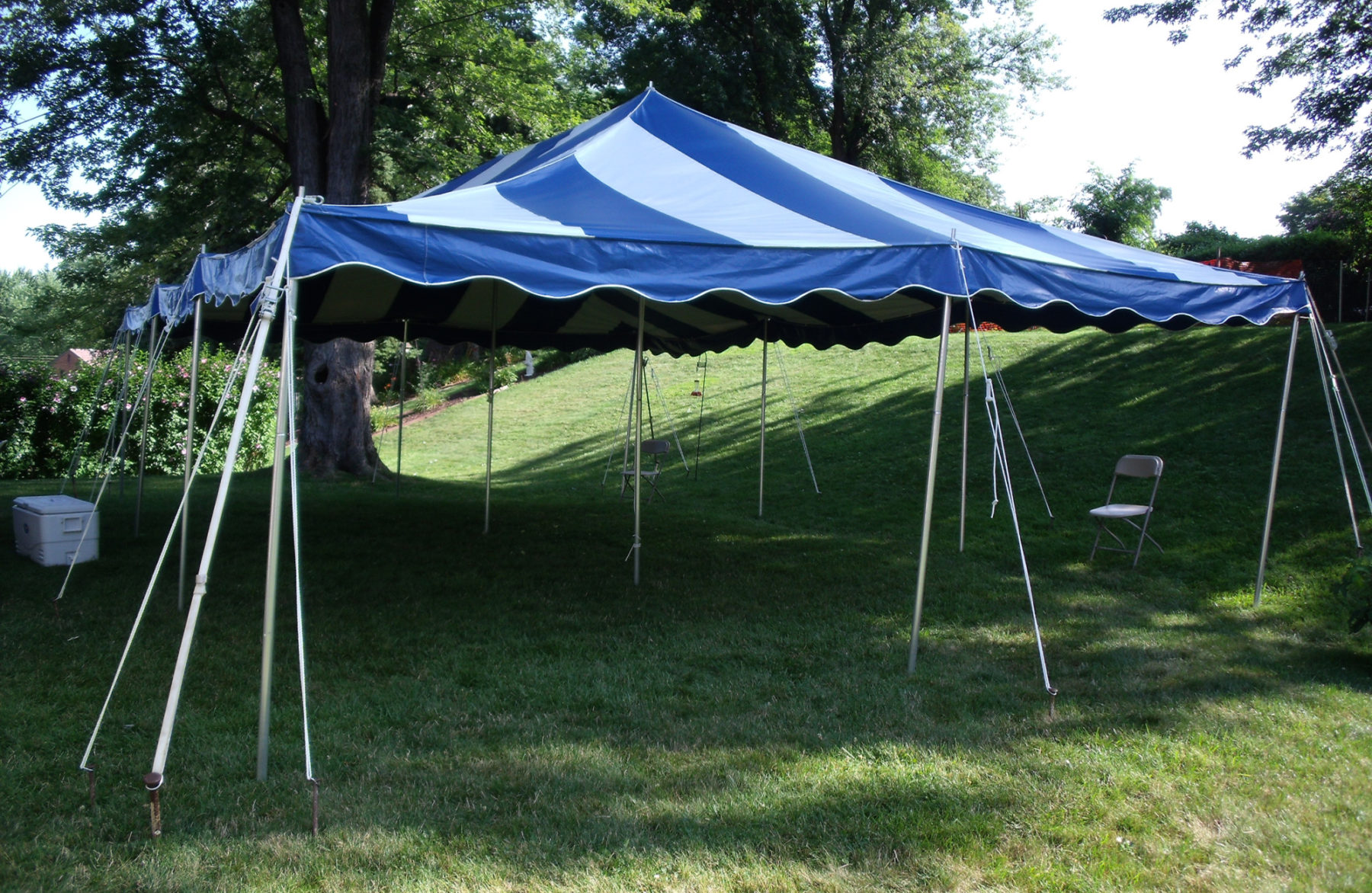
These are a lightweight vinyl covering designed to provide shade and protection from a light rain. They must be installed in an area where stakes can be driven into the ground on all four sides. In most cases, these are rented for installation by the customer for small backyard gatherings. They come complete with poles, stakes, ropes, and installation instructions. Common sizes are 15’x15’ and 20’x20’, which can be installed by two people in 30 minutes or less. Some party canopies are equipped with sidewall ropes to allow for the addition of sidewalls.
Advantages of party canopies:
Their relatively low cost, and ease of installation.
Disadvantages of party canopies:
Their inability to handle strong winds, or heavy rain, and their relatively small sizes.
Heavy-duty Pole Tents, also known as Party Tents / Tension Tents, and various trade names
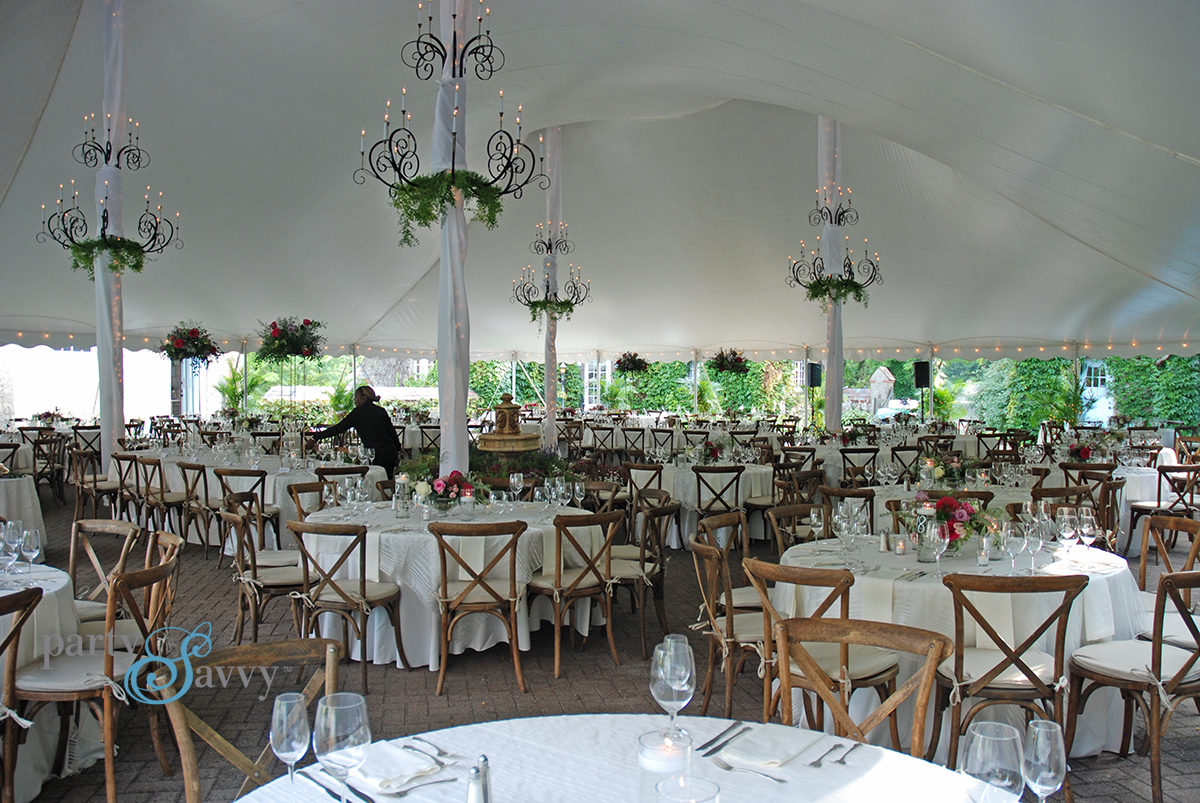
These are very heavy-duty vinyl tents that must be professionally installed on sites where staking is possible around the entire perimeter of the tent. Installations are typically done on lawn areas, or on asphalt parking lots. The most common sizes available for rental are 40’ wide and 60’ wide; smaller & larger widths are also available. The length of the tent varies based on the size and quantity of tent sections that are laced together to achieve the amount of space needed for the event. Many of the pole tents being manufactured today are engineered “tension tents” that are engineered and certified to withstand significant wind loads.
Advantages of heavy duty pole tents:
- The wide range of sizes available, as well as their ability to withstand most adverse weather conditions.
- Pole tents generally cost less than frame tents of a comparable size.
Disadvantages of heavy duty pole tents:
- The fact that they do have some number of center poles in the interior which must be considered when placing furniture.
- Pole tents require more space to install than frame tents of the same size.
- Many potential tent sites don’t allow for driving tent stakes into the ground; pole tents must be staked.
Frame Tents
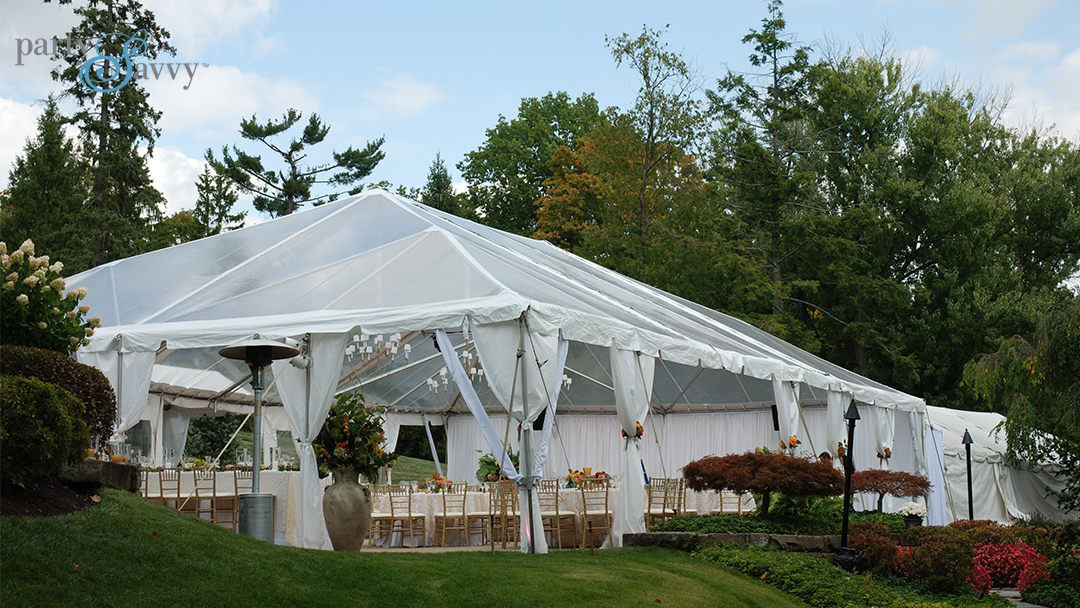
- The term “frame tent” is generally used to describe a wide variety of tents that are supported by a metal frame (usually aluminum), and have NO interior poles.
- Frame tents may be as small and as simple as an 8’x8’ “pop-up” canopy, and as large as 50’ wide and virtually any length.
- Most frame tents feature a vinyl tent top which is secured to a metal frame.
- High-peaked frame tents have a center pole that sits on top of “X” cables that are installed from the top of one corner pole to the top of the opposite corner pole. They do not have any framework in the ceiling of the tent, as most frame tents do.
- Most standard frame tents have frames that are made of round aluminum tubing.
- Track style frame tents feature extruded aluminum frames that allow the vinyl tent tops and sidewalls to be installed by sliding each top or wall section through tracks in the frame, much like a clear-span structure.
- Marquees / Walkway canopies, are small frame-style tents that are typically used to create a covered walkway to connect one tent to another, or to create an entrance to a larger tent. Marquees typically have flat (gable ends), unlike most frame tents, which have sloping (hip) ends.
- Marquees may be installed individually for use as a bar tent, buffet tent, valet tent, registration tent, etc..
- In most cases, frame tents need to be installed by professional tent installers.
- Frame tents can be custom-built to accommodate many unique sites.
Advantages of frame tents over pole tents:
- Frame tents come in a wide variety of sizes from 6’ wide to 50’ wide.
- Frame tents are very versatile, and can be used in many places where a pole tent could not be used, such as patios and decks that are up against a building or a house.
- Frame tents can be installed against each other, with a rain gutter between them.
- Frame tents do NOT have any interior poles; the interior space is unobstructed.
- Frame tents are often height adjustable.
- Frame tents provide a lot of opportunities for hanging things such as lighting, décor, etc., subject to weight limitations.
- Frame tents will stand up by themselves, however, they do need to be anchored by staking, or by ballasting to prevent them from being moved under windy conditions. Unlike pole tents, which must be anchored by tent stakes, frame tents may be anchored with some sort of ballasting / weights, when staking is not possible or not permitted.
- Frame tents are available with clear vinyl tops, in addition to white tops.
Disadvantages of frame tents:
- Frame tents are generally more expensive to purchase, and to rent, compared to pole tents, mostly because of the cost of the frame, and sometimes, special equipment that is needed to complete the installation.
Clear Span Structures (also known as Clear-spans, or structure tents, or structures)

- These are very heavy-duty frame-style tents that feature extruded aluminum box beam construction with heavy weight vinyl roof panels and sidewalls.
- Clear spans are available in a wide variety of widths from quite small to very large.
- Clear spans sizes are generally metric (10 meter, 20 meter, 25 meter, etc. in width) by whatever length is needed, generally in 5 meter increments.
- Side pole heights are generally taller than most frame tents or pole tents; typically, 11’ or taller.
- Clear spans must be anchored by driving tent stakes through the baseplates at the bottom of each side pole / upright, or by ballasting.
- Clear spans will withstand severe weather conditions, and are suitable for long-term installations.
- Vinyl roof panels and sidewalls are installed by sliding them through tracks in the extruded aluminum framework after the framework has been completely erected.
- Some clear spans are available with double or triple decks; these are often used for sporting events, such as golf tournaments.
- Structures can be outfitted with flooring, carpeting, lighting, heat, air conditioning, doors, and so on.
Advantages of clear span structures:
- Clear spans are very versatile.
- Clear spans are very heavy duty and are suitable for long-term installations.
Disadvantages of clear span structures:
- Clear spans are expensive to purchase, and to rent.
Sidewalls
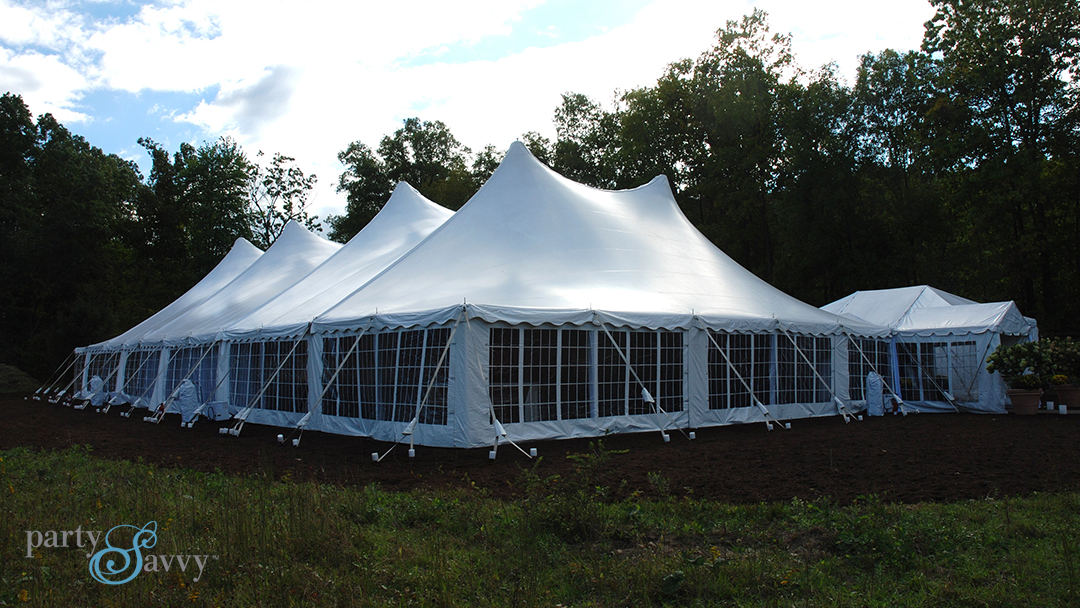
Most tents are designed to accommodate sidewalls. Party canopies, heavy-duty pole tents, and most frame style tents are equipped with sidewall ropes around the perimeter, on the inside; the sidewalls have clips along the top edge that are used to hang the sidewalls on the sidewall rope. Sometimes, when windy conditions are expected, the sidewalls can be anchored on the bottom by using wall stakes, or by other methods when staking is not possible.
Track style frame tents, and clear span structures use sidewalls that are designed to slide through tracks in the frame, which makes them much more secure, and less likely to flap in windy conditions. Some tents even have sidewalls systems that use steel rods through a “pocket” built into the bottom of the sidewall to secure them along the bottom. This is especially useful when the tent needs to be sealed for heating or air conditioning.
An advantage of the track style sidewall system is that each sidewall is typically made in two sections that lace together in the center; these can be un-laced, which allows the walls to be opened by sliding one section to the right and one to the left, up against the side pole where it can be secured with a strap. This allows the walls to easily be opened, and closed as needed without having to remove them from the tent.
Sidewalls are typically available in three styles, which are solid white vinyl, clear vinyl, or window style walls. Window walls are available in two styles, cathedral, and French. Cathedral window walls have an arched top, whereas the French window walls feature square panes.
White sidewalls are used in situations where you don’t need people to see in or out of the tent, or in situations where you need the tent to be darkened for a video presentation. We typically use white sidewalls to enclose a catering prep tent (field kitchen), or a restroom trailer tent, for privacy.
Clear side walls are probably the most popular choice, as they allow people to see into and out of the tent, and make the tent feel more open, and brighter.
Window sidewalls are typically used for their decorative effect.
Sidewalls are useful for a variety of reasons; they provide protection from wind and/or rain, and are used to enclose a tent when heat or air conditioning is being used.
Sidewalls are available in various heights, and need to be matched to the height of the tent’s side poles.

